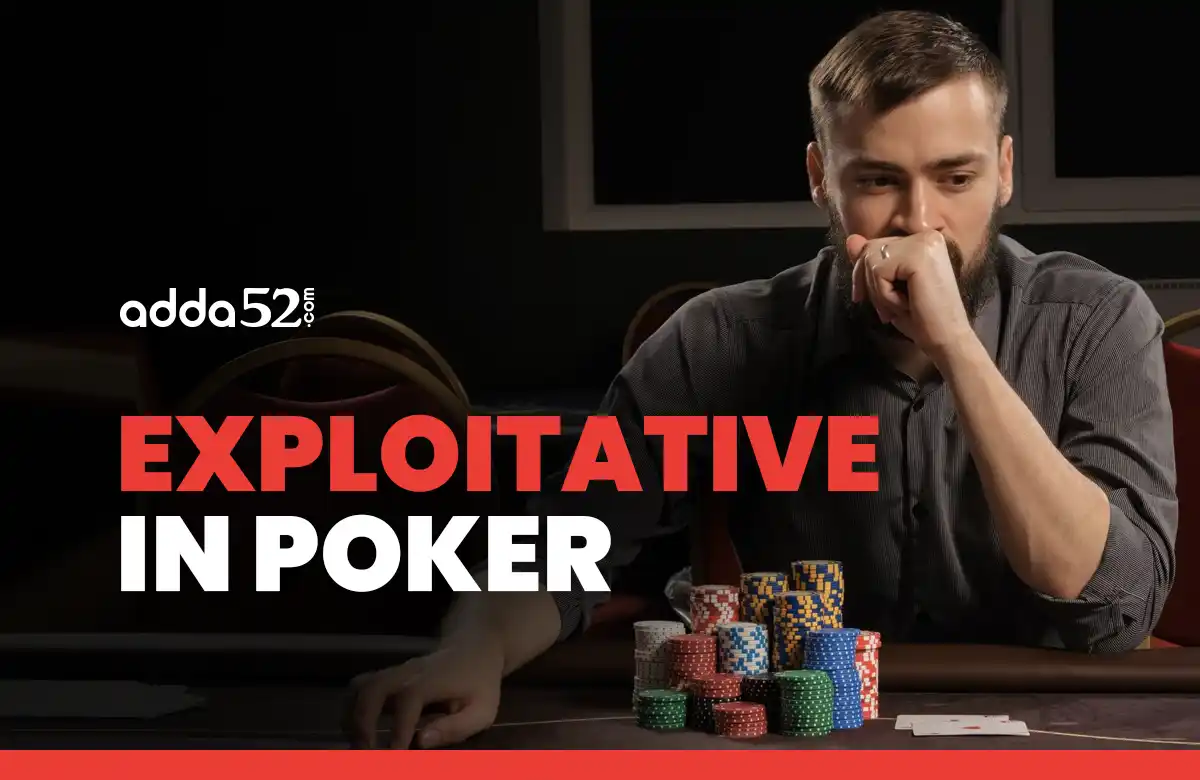
Introduction
Players use various strategies to outwit opponents, but one of the most effective approaches is exploitative Poker. While some players rely on the math-heavy framework of Game Theory Optimal (GTO), exploitative Poker takes a more flexible, opponent-specific approach.
In this article, we will take a closer look at what it truly means.
Understanding Exploitative Poker
Exploitative Poker is an approach that focuses on identifying and exploiting your opponents' mistakes or weaknesses. The goal is simple: maximize profits by targeting weak spots in your opponents' play.
At its core, exploitative Poker involves adjusting your strategy to capitalize on your opponents' errors. Every player at the table has certain tendencies, whether they are too loose or tight, overvalue certain hands, or make incorrect calls. Understanding these tendencies allows you to exploit them and maximize your expected value (EV).
How to Excel at Exploitative Play
To master at exploitative Poker, you need to have a solid understanding of the following key components:
- Opponent Profiling: The first and most important step in exploitative Poker is recognizing the specific flaws in your opponents' gameplay. These flaws might include anything from overly tight play, excessively loose play, or predictable bluffing patterns.
- Adjusting Your Ranges: Once you have identified an opponent’s weakness, you can adjust your opening ranges, calling ranges, and betting patterns to exploit it. For example, if you notice an opponent folding too much to 3-bets, you can expand your 3-betting range to include more bluffs and value hands.
- Bet Sizing: Adjusting your bet sizing is a powerful way to exploit weak players. If you know an opponent calls too often, you can make larger value bets with strong hands. Conversely, smaller, more frequent bets may be the best way to steal pots if they fold too much to aggression.
- Table Position: You need to adjust your play depending on your position at the table. Players in later positions can usually exploit those in earlier positions by stealing blinds and isolating weaker players.
How to Identify Opponents’ Weaknesses
The first step is to identify the common weaknesses of your opponents. These weaknesses can vary depending on the player type, but they generally fall into one of these categories:
Loose Players (Calling Stations)
Loose players play a wide range of hands and often call a lot, often with weak holdings. While this might seem like a good thing in terms of collecting pots, the real key is that these players allow you to extract more value.
- How to Exploit: The primary way to exploit calling stations is by increasing your value bets. With a strong hand, make larger bets to maximize your expected value. Since they will call with a wide range of hands, they will often pay off your strong hands, even when they have little chance of winning.
Example: If you are holding pocket aces and the flop is favourable for you, such as 9♠ 6♣ 3♠, a loose player will likely call with any pair, straight draw, or flush draw. By making larger bets, you increase the value of your strong hand, extracting more chips from them.
Tight Players (Nits)
Tight players are very selective about the hands they play. They mostly fold a lot, especially when faced with aggression. This can make them very predictable and easy to exploit.
- How to Exploit: You can exploit tight players by applying consistent pressure. If they are folding too often, you can open your range and steal more pots, especially in the late position. Aggressive pre-flop raises and frequent continuation bets often force tight players into uncomfortable situations, causing them to fold too frequently.
Example: In a late position, you might raise with a hand like 8♠ 7♠ and steal the blinds, especially if a tight player is in the small blind and folding a wide range of hands to raise.
Over-Aggressive Players (Maniacs)
Over-aggressive players, often referred to as maniacs, love to raise and bet without much thought to the strength of their hands. They can be tough to play against if you don't know how to deal with their aggression.
- How to Exploit: You can counteract their aggression by trapping them with strong hands. Call or re-raise with solid holdings, knowing the maniac will continue to bet aggressively. You can also use their tendency to bluff too much against them by calling with a wide range of hands, as they often overestimate the value of their bluffs.
Example: If an over-aggressive player raises pre-flop and continues with a large bet on the flop, you might re-raise with a hand like pocket kings. The player will likely push their hand further, putting more chips into the pot with little chance of winning.
Passive Players (Weak Tight)
Passive players call, particularly with weaker hands. They tend to avoid aggression and rarely take the initiative.
- How to Exploit: You can exploit passive players by betting more frequently with a broader range of hands. Since they rarely raise, you don’t have to worry about being re-raised, and you can often steal pots with a well-timed continuation bet or even a value bet with marginal hands.
Example: If you are in position and the passive player checks to you, make a bet even with a weak hand. You can often pick up pots with minimal risk if they are likely to call with anything.
Players Who Overvalue Hands
Some players tend to overvalue certain hands, especially hands like top pair or weak two pairs. They often continue betting or calling with these hands, even when faced with aggression.
- How to Exploit: You can exploit these players by raising with hands that have the potential to beat their top pair, such as drawing hands or even bluffs. If you can represent a stronger hand, they will often pay off your bets because they overvalue their hand.
Example: You might raise a player who holds the top pair with a weak kicker when the board shows potential straight or flush draws. You can either semi-bluff or raise to extract value if they continue betting.
How to Adjust Your Play Based on Table Position
Here are a few ways to adjust your play:
- Early Position: In early position, you want to play a more conservative range of hands. However, against opponents who are likely to fold too often or play too passively, you can widen your opening range and add some steals.
- Late Position: Late position gives you the advantage of seeing what your opponents do before you act. You can exploit players who are too tight in early positions by stealing more blinds or raising wider ranges.
- Multiway Pots: You have to be more selective with your bets in multiway pots. Exploit passive players by betting larger while avoiding giving free cards to aggressive players who are likely to bluff.
Adjusting Bet Sizing for Exploitative Play
Bet sizing is one of the most crucial tools in exploitative poker. Proper bet sizing allows you to maximize your EV by increasing value against weak players and applying pressure to those who fold too often.
- Against Loose Callers: Make larger value bets when you have a strong hand to get more chips into the pot. Loose players are likely to call with a wide range of hands, so you want to size your bets to maximize value.
- Against Tight Players: You can use smaller bets to force folds from tight players, especially when you are bluffing or semi-bluffing. If they fold too often, smaller, frequent bets will win you more pots.
- Against Aggressive Players: When facing aggressive players, make larger bets with strong hands to trap them. When confronted with large bets, they often overvalue their hands and make mistakes.
Frequently Asked Question
What is Exploitative Poker?
Exploitative Poker is a strategy for adjusting your play to capitalize on your opponent's weaknesses. By identifying their flaws, you can increase your profit by targeting these weaknesses through strategic betting, hand selection, and bluffing.
Is Exploitative Poker suitable for all player types?
Exploitative Poker works best when playing against opponents who have noticeable weaknesses. Against weaker players, exploitative strategies can deliver great returns.
Can you use Exploitative Poker in tournaments?
Yes, exploitative Poker is highly effective in tournament play. It can be even more profitable due to the tournament's increased variance and structure. Capitalizing on players’ habit of overvaluing hands can increase your stack and knock out opponents.
Conclusion
Exploitative Poker is all about using your opponents' mistakes against them. This strategy requires observation, adaptability, and a deep understanding of the players you face. Customizing your play depending on who you are facing helps you make more profitable choices.
